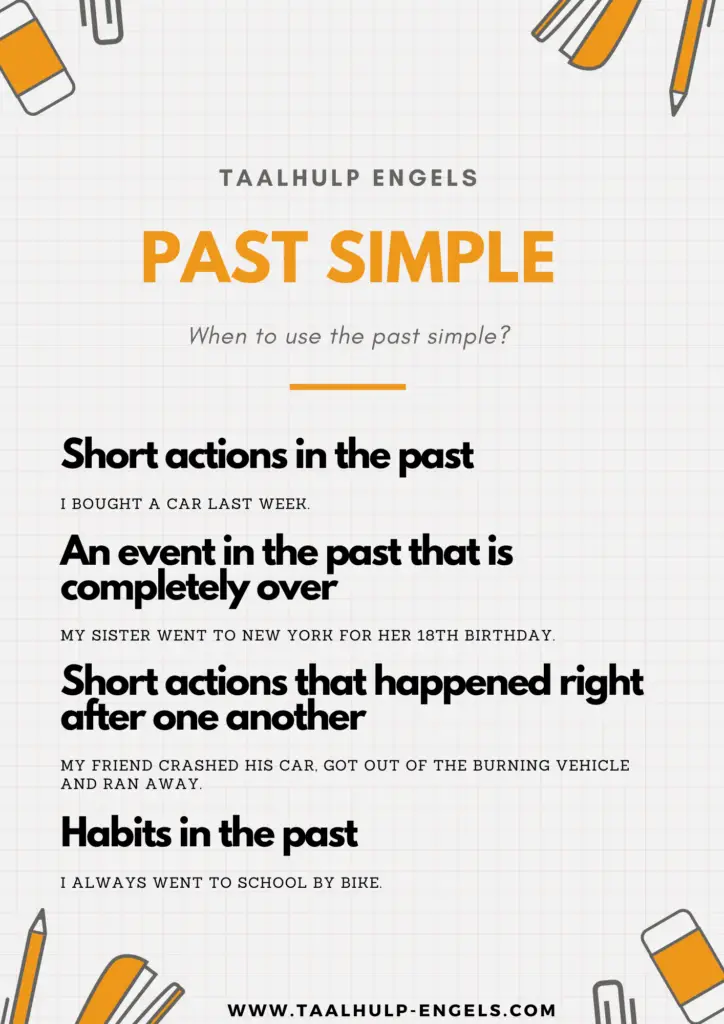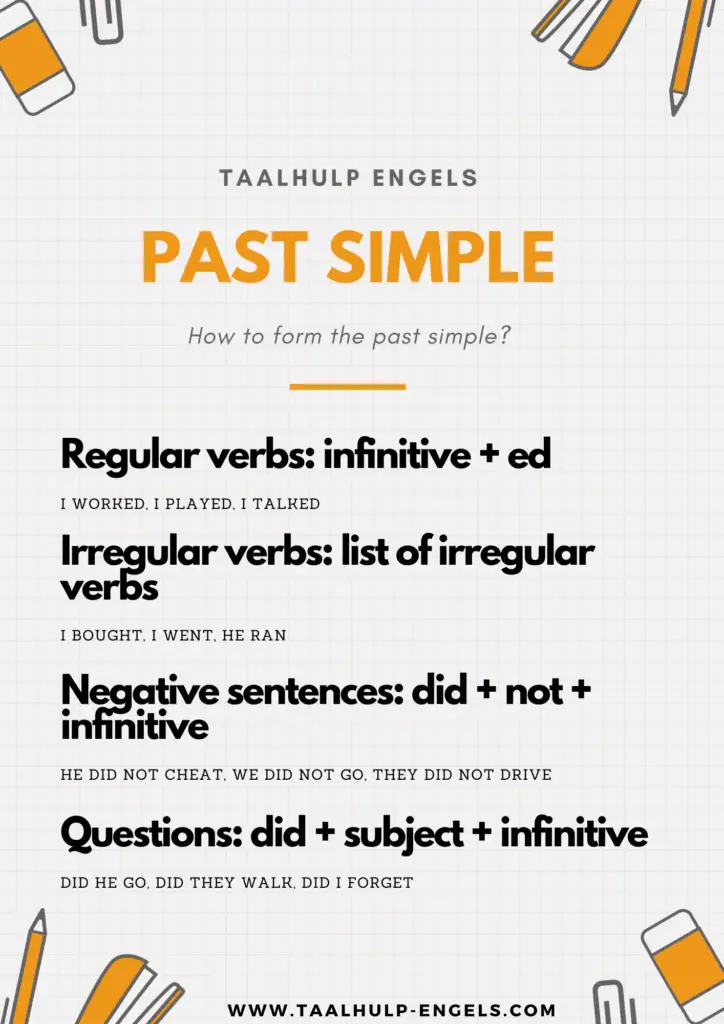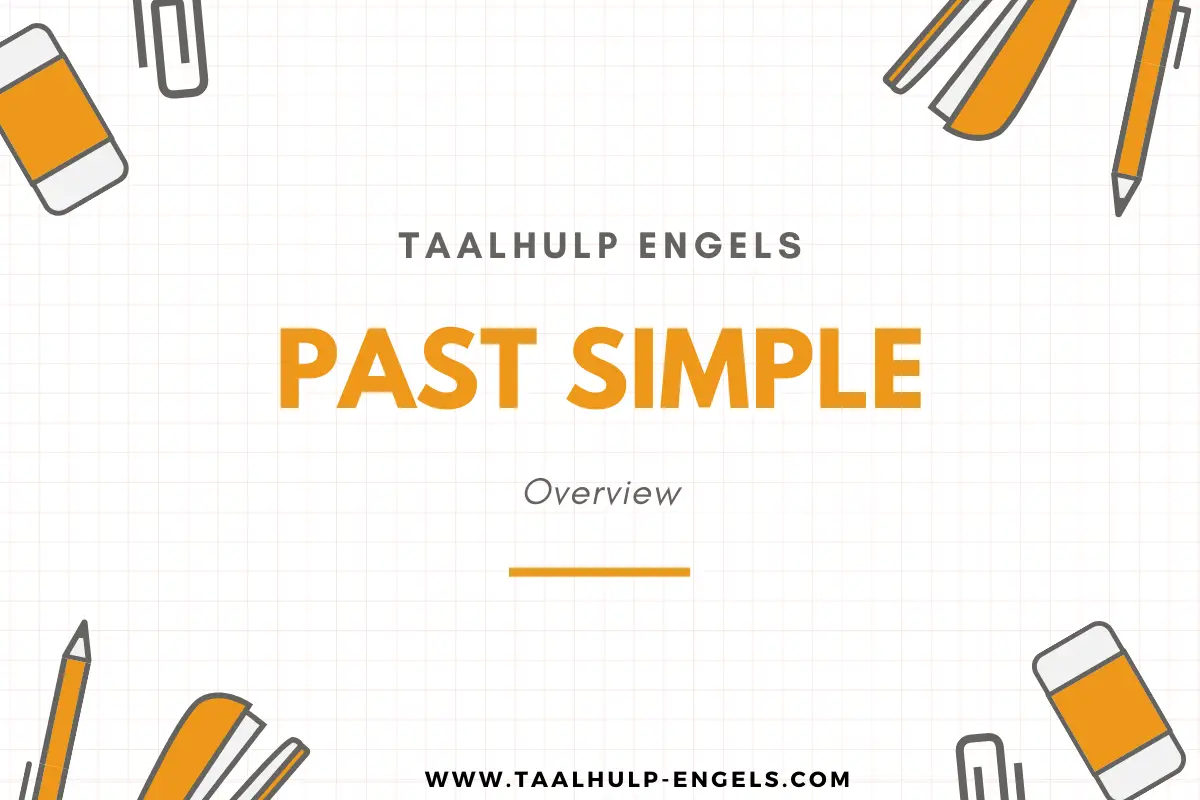The past simple (or simple past) is a basic tense to talk about events that happened in the past. On this page, you have a detailed overview of what this tense is, when to use it, how to form it.
Past simple (or simple past) tense
You use the past simple to talk about actions, states or events in the past. It’s important that those actions, events or states are completely over and that you cannot change them anymore. You can find more information below about the different situations in which you can use the past simple:
Short actions that happened in the past
- I bought a new car last week.
Something that happened in the past without any link to the present. The action or event is completely over.
- My sister went to New York for her 18th birthday.
Short actions in the past that happened right after one another
- My friend crashed his car, he got out of the burning vehicle and ran away.
Habits in the past
- I always went to school by bike.


How to form the past simple
Past simple positive
There are multiple ways of forming the past simple (or simple past). The general rule is that you need to add <ed> to the infinitive. This is the rule of thumb for regular verbs. For example:
| I worked |
| You worked |
| He/she/it worked |
| We worked |
| You worked |
| They worked |

When the infinitive ends in <y>, you drop <y> and add <ied> instead.
- He carried the groceries (to carry).
If the verb ends in <e> or <a>, you only add <d>.
- I used that car (to use).
When you have an infinitive of one syllable with a short vowel (a, e, i, o, or u), you double the final consonant.
- My friend chopped a tree (to chop).
If you have a verb ending in -el, you double the <l>.
- I channelled my inner spirit (to channel).
When the verb consists of two syllables and the stress is on the final syllable, you double the final letter.
- I submitted the form (to submit).
All other verbs are irregular and you need to study those. A list of most irregular verbs is available over here.
- I ran a marathon (to run).
Past simple negative
If you want to make the negative form of the simple past, you use the past simple of the auxiliary verb ‘to do’ (did) + ‘not’ + the infinitive of the main verb. You need:
did + not + infinitive
| I did not work |
| You did not work |
| He/she/it did not work |
| We did not work |
| You did not work |
| They did not work |
If you want to make the negative form of ‘to be’ in the past simple, you conjugate ‘to be’ and put ‘not’ right after the verb.
| I was not |
| You were not |
| He/she/it was not |
| We were not |
| You were not |
| They were not |
Past simple questions
If you want to form a question in the simple past, you use the simple past of ‘to do’ (did), followed by the subject of the sentence and the infinitive of the main verb.
| Did I work? |
| Did they work? |
| Did he/she/it work? |
| Did we work? |
| Did you work? |
| Did they work? |
If you ask a question and the answer to that question is the subject, you do not use an auxiliary verb. For example:
| Who worked? |
| Who played a game? |
If you want to form a question with the verb ‘to be’, you put the verb in front of the subject. Some examples:
| Was I? |
| Were you? |
| Was he/she/it? |
| Were we? |
| Were you? |
| Were they? |
Time indicators
If you have one of the following words in a sentence, it’s usually an indication that you are dealing with a past simple.
- Last week, last month, ten years ago, in 1990, yesterday, …
Examples
| Positive | Negative | Question |
| I worked He sang | I didn’t work He didn’t sing | Did I work? Did he sing? |


Past simple exercises
- Exercise 1
- Exercise 2
- Negative Exercise 1
- Negative Exercise 2
- Questions Exercise 1
- Questions Exercise 2
- Mixed Exercise 1
- Mixed Exercise 2
- Mixed Exercise 3
- Mixed Exercise 4
- Mixed Exercise 5


